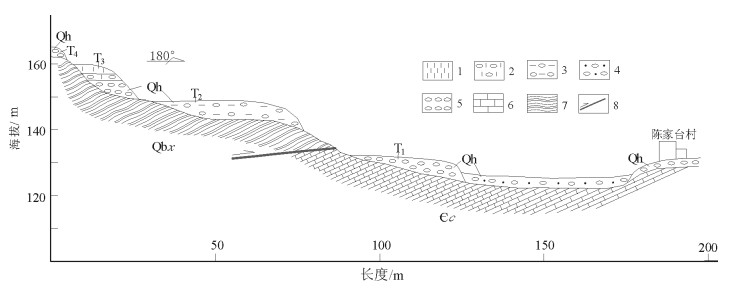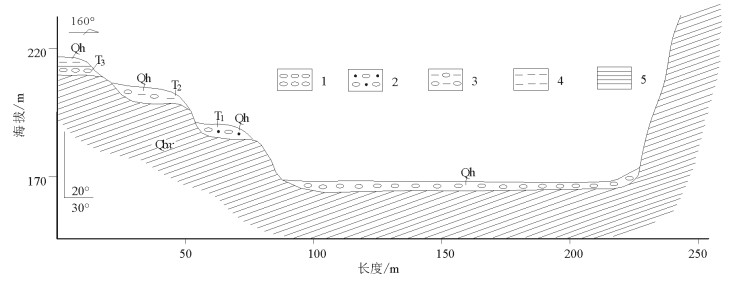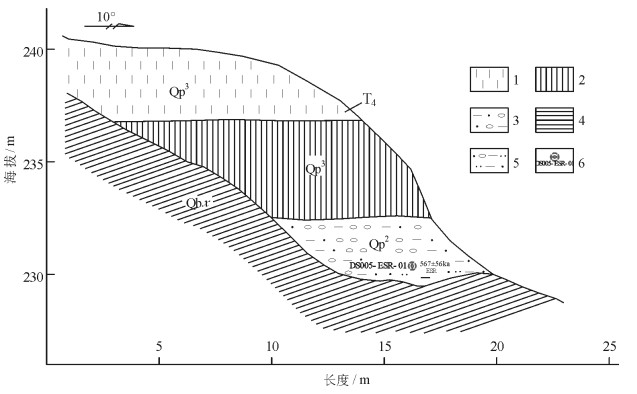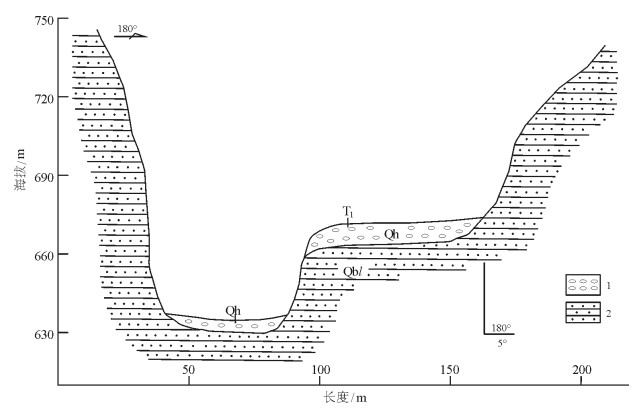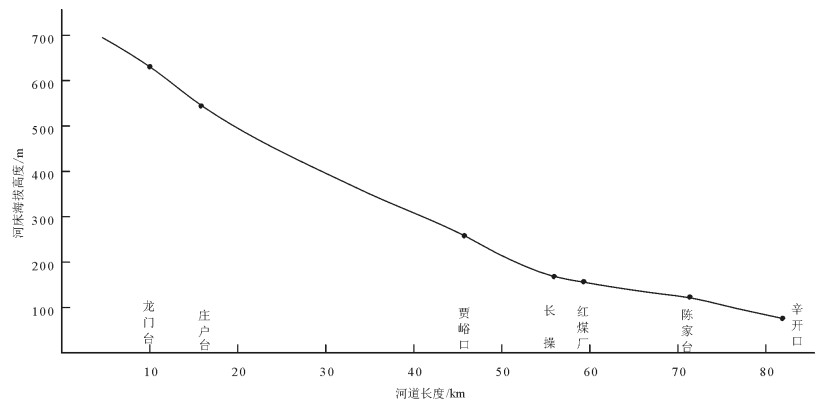Terrace development characteristics of Dashi River valley in Western Hills of Beijing
-
摘要:
大石河山峡总体上阶地较发育,阶地类型以基座阶地为主。下游陈家台-红煤场一带1~4级阶地发育较全,上游至庄户台一带,阶地数量减少,仅见一级阶地。上游沉积物多为砾石,砂、粘土等含量较少;而至下游,沉积物中砂、粘土组分的含量增加。红煤厂四级阶地棕红色泥质含砾粉砂中获得ESR年龄567±56ka,显示大石河河谷在第四纪中更新世早期初始发育,由于新构造运动产生间歇性隆升,在高位宽谷之下发育4级阶地,形成了如今的地貌特征,对比得出大石河流域辛开口至龙门台一段(山区)平均比降为7.71‰,600ka以来,大石河流域山区隆升速率为0.96mm/a。
Abstract:Terrace is developed in Dashi River valley. It is mainly bed rock seated terrace. The first to fourth terraces are relatively well developed from Chenjiatai to Hongmeichang in lower reaches. Only one terrace is seen in upstream Zhuanghutai Village. The sediments are mainly gravels and sands in upstream reaches. They are sands and clays in lower reaches. The dating of fourth terrace in Hongmeichang Village yielded an age of 567±56ka, suggesting that the Dashi River was formed in Mid-Pleistocene. The four terraces were formed by uplift of New Tectonic Movement. The longitudinal river slope is 7.71‰ from the river mouth of Xinkaikou Village to Longmentai Village in upstream reaches. Since 600ka, the Hill in Dashi River valley has been uplifted by 0.96mm/a.
-
Keywords:
- Dashi River /
- terrace /
- longitudinal river slope /
- ESR dating /
- Beijing Western Hills
-
阶地指由于地壳上升,河流下切形成的阶梯状地貌。北京西山的隆升影响了大石河阶地的形成,阶地的研究对全面解析新构造运动的隆升意义重大。
北京西山从北向南依次分布永定河、大石河和拒马河3条河流,其中大石河形成时代最新,目前尚未见到公开发表的研究文献,对大石河阶地的研究对北京西山的新构造运动隆升有实际意义。
大石河属海河流域大清河水系北拒马河支流。发源于霞云岭乡堂上村西北,是唯一发源于房山境内的河流,《水经注》称“圣水”。大石河总流域面积为1280km2,河道全长129km,其中辛开口村以上山区河道长85km(平均比降为6.4‰),辛开口村至夏村长15km(平均比降为3‰),夏村至北京市界长21km(平均比降为0.3‰)[1]。流域内多年平均降水量600mm左右,多年平均天然径流量9570 × 104m3,枯水年天然径流量4785×104m3。建国后大石河下游发生过多次洪水灾害,1956年洪水流量为1860m3/s,是漫水河水文站实测最大洪峰流量[2]。
大石河是北京西山发育的一条未侵蚀至分水岭的河流,其阶地发育特征代表了北京西山隆升的发展过程,对北京地区现今地形地貌、新构造运动和平原区堆积物层序研究具有重要意义。
北京西山的基础地质[3]和新生代地质研究详细[4],也曾研究过永定河阶地[5],1:5万周口店幅曾测制陈家台河谷剖面[6],为大石河阶地的全面研究奠定了基础。本文对陈家台村—霞云岭乡堂上村河谷阶地进行了调查(图 1),对不同位置阶地发育特征进行了研究,结合沉积地层分析和阶地面高程测量,初步计算了大石河流域不同时代阶地的垂直落差,探讨了大石河流域山体中更新世以来隆升的速率。
1. 大石河阶地剖面特征
大石河流域陈家台村至霞云岭乡堂上村(山区)穿切的地层主要为长城系、蓟县系、青白口系和寒武系、奥陶系及少量二叠系,岩性主要为碳酸盐岩类的灰岩、白云岩类及陆相碎屑沉积岩(图 2)。河流阶地普遍发育,依序介绍如下。
1.1 陈家台河谷阶地特征(P01)
阶地地处房山区佛子庄乡陈家台村,阶地发育在河床左侧,共发育4级(图 3)。
河床宽56.6m,海拔125m,主要为砾石,含少量粗砂。砾石大小5~20cm,大者大于20cm,磨圆度较好,岩性以灰岩为主,含少量火山岩、砂岩砾石。
一级阶地(T1)为堆积型阶地,宽63.4m,主要为砾石,砾石特征与河床砾石相近。
二级阶地(T2)为基座型阶地,宽51.7m,阶高15.5m,基座为下马岭组千枚状板岩,向东追索,基座可见昌平组灰岩。二级阶地前缘上部为全新统河流洪积物,岩性为泥质砾石。泥质为土黄色,含量30%~40%,局部含量较高,砾石分选性中等,磨圆度中等,大小以小于5cm为主,10~20cm次之,成层性一般,砾石成分较复杂,灰岩砾石为主,见少量石英砂岩和火山岩砾石。底部见棕黄色粉砂质粘土透镜体,厚约60cm,长5.6m,走向320°,上覆泥质砾石,厚约3m。二级阶地后缘岩性为砾石层和土黄色粘土。砾石层含少量泥质,砾石大小约5cm,分选性、磨圆度中等,砾石成分同前缘一致,分选性、磨圆度中等。土黄色粘土粒度细,不含砾石,钙质含量较高,土质较硬,顶部20cm含少量砾石,砾石分选性、磨圆度均较差。
三级阶地(T3)为基座型阶地,阶宽15.3m,阶高2.8m,基座为下马岭组千枚状板岩。底部为砾石层,砾石大小约为5cm,分选性、磨圆度较好,为复成分砾石,主要为灰岩砾石;中部为土黄色含砾粘土,厚约80cm,砾石含量较少,均为千枚岩岩片,小于2cm,无磨圆;上部为土黄色粘土,厚约40cm,粒度细,手搓有滑感,湿时可搓成细条,不易断,为较典型的河流冲积、洪积产物。
四级阶地(T4)为基座型阶地,阶高9.5m,主要为砾石。砾石大小约为10cm,分选性、磨圆度中等,岩性以灰岩为主,含少量火山岩、砂岩砾石。基底为下马岭组千枚状板岩。
1.2 红煤厂河谷阶地特征
1.2.1 红煤厂公路边阶地特征(P02)
阶地地处房山区佛子庄乡红煤厂村,阶地发育在河床左侧,共发育3级。
河床宽135m,海拔167.1m,主要为砾石,大小不等,大者大于20cm,一般为5~10cm,磨圆度较好,岩性以灰岩、火山岩、砂岩砾石为主(图 4)。
一级阶地(T1)为基座型阶地,阶宽19.2m,阶高21.1m,基座为下马岭组灰黑色页岩,基座上主要为粗砂质砾石,砂含量20%~30%,砾石大小约10cm,分选性、磨圆度中等,成分主要为灰岩,见少量火山岩、砂岩砾石。为较典型的河流冲积、洪积物。
二级阶地(T2)为基座型阶地,阶宽10.8m,阶高3m,基座为下马岭组灰黑色页岩。基座之上覆盖较严重,零星可见砾石发育,含泥质成分,含量约15%,泥质为土黄色,手搓有滑感,粒度细。砾石砾径10cm左右,分选性、磨圆度一般,以灰岩砾石为主,含少量火山岩和砂岩。为河流洪积产物。
三级阶地(T3)为基座型阶地,阶宽大于10m,阶高7.1m,基座为下马岭组灰黑色页岩,产状20°∠30°。按岩性分为4层。
1层:土黄色粘土,粒度细,砾石含量少,层状,厚约1.5m,延伸稳定,为水平层。
2层:含泥质砾石,延走向厚度不稳定,最薄处厚约1.5m,最厚为3m。砾石未胶结或松散胶结,分选性、磨圆度中等,砾径以5~10cm为主,大者可达20cm,砾石岩性为灰岩、页岩和少量火山岩。
3层:土黄色粘土,岩性与1层一致。延伸不稳定,厚0.5~1.5m,透镜体状产出。
4层:含泥质砾石,沿走向厚度有变化,厚1.1~ 3.6m,砾石胶结差,分选性、磨圆度中等,砾径多小于5cm,成分为灰岩、火山岩和页岩。
三级阶地上发育较典型的河流冲积、洪积物。
1.2.2 红煤厂西黄土台阶地特征(P03)
阶地地处房山区佛子庄乡红煤厂村西,阶地发育在河床右侧,为河流四级阶地,海拔230m(图 5)。
该阶地属基座型阶地,基座为下马岭组页岩,基座上为3套岩性,由上而下描述如下。
1层:土黄色粘土,粒度细,手搓有滑感,硬度较大,含钙质,未见砾石发育。厚约3m。
2层:棕红色黄土,粒度细,较硬,发育垂直节理,手搓有滑感,湿时可搓成条,不易断,未见砾石发育。厚3~4m。
3层:含砂泥质砾石,底部见薄层棕红色含砾泥质粉细砂。泥质为棕红色,粒度细,节理不发育,硬度较大。上部砂质含量相对较少,砾石磨圆度较好,分选性一般,砾径5cm左右,大者10~20cm,成分以灰岩、页岩为主。厚2~3m。
该阶地发育的岩石类型具有河流沉积和风积混合成因特点。
1.3 长操北岸二级阶地特征
阶地位于房山区佛子庄乡长操村西北,阶地发育在河床左侧,为二级阶地,海拔185m,河床海拔约175m。阶地属于基座型阶地,基座为下马岭组页岩,由上而下共分为5层。
1层:粉砂质粘土,土灰色、土黄色,粒度较细,手搓略有涩感,未见砾石,植物根系发育。
2层:含砾粗砂质细砂,土灰色,粒度不均匀,砂质含量约占80%,砾石大小约为2cm,分选性、磨圆度较好,以灰岩、页岩砾石为主,含少量泥质。
3层:土黄色粉砂质粘土,粒度均匀,较细,硬度大,手搓略有涩感,砾石很少。
4层:土灰色细砂,无胶结或松散胶结,硬度小,层状,分选性、磨圆度较好,砾石少见。
5层:砾石层,砾石大小2~10cm,分选性差。大砾石磨圆度中等,小砾石磨圆度较差,砂质充填。
该剖面岩石成层性较好,发育泥、砂二元结构,为较典型的河流冲积产物。
1.4 贾峪口村西三级阶地特征
阶地位于房山区佛子庄乡贾峪口村,阶地发育在河床左侧,为河流三级阶地,阶地属于基座型阶地,河床海拔282m。该剖面由上而下共分为16层,为土黄色粘土和砾石层互层状产出,其中8层砾石,8层土黄色粘土。上部砾石层和黄土层较厚,最厚处为1~1.5m,底部粘土层较厚,砾石层多为薄层,沿走向延伸较稳定。
粘土为土黄色,质地较硬,钙质含量较高,局部粉砂质含量略高,手搓较细,有砂感,局部含少量砾石。
砾石松散,砾径以5~10cm居多,大者可达20cm,分选性差,次棱角状磨圆,局部泥质充填。砾石成分较复杂,以白云岩为主,含少量火山岩和砂岩,为近源沉积的产物。
1.5 庄户台村一级阶地特征(P04)
阶地位于房山区霞云岭乡庄户台村,阶地发育在河床右侧,为河流一级阶地,阶地高30m,属基座阶地,基座为龙山组纹层状砂岩,产状平缓,倾角4°~5°,阶地海拔665m,河床海拔635m。
基座上为砾石层,泥砂质充填,松散胶结,砾石为次圆状-圆状磨圆,分选性差。大小以10~20cm为主,小者约5cm,大者50~80cm。砾石层厚3~4m,主要为河流洪积搬运的产物(图 6)。
1.6 龙门台村一级阶地特征
阶地位于房山区霞云岭乡龙门台村,发育在河床左侧,为河流一级阶地,阶地高约10m,属于基座型阶地,基座为龙山组砂岩,产状平缓,阶地海拔645m,河床海拔635m。
根据不同岩性,由上而下可分为4层。
1层:砾石层,泥砂充填,砾径以5~10cm居多,大者逾20cm,岩性以砂岩为主,分选性差,磨圆度中等,为流水搬运成因。
2层:土黄色粘土,粒度细,硬度中等,局部粉砂含量较高,见少量残积碎石,大小为5cm,岩性均为砂岩。
3层:残坡积物,由粘土、残积碎石及少量砂质组成。粘土为棕红色,砂质以中细砂为主,碎石无分选、无磨圆,砾径为5~20cm,大者达50cm,岩性单一,均为砂岩。
4层:棕红色粘土,粒度细,手搓较滑,硬度大,内部见少量残积碎石。
根据该剖面物质组成分析,龙门台村一级阶地早期为河流洪积粘土层,之后为近源的残坡堆积,晚期经历流水搬运沉积的粘土层和砾石层。
2. 样品采集与测试
2.1 样品采集
样品采自红煤厂西黄土台河流四级阶地之上(P03),样品号为DS005-ESR-01(图 5),位于剖面第3层底部,采样层厚度约20cm。采样处泥砂质成分较高,岩性为棕红色含砾泥质粉细砂。
2.2 样品测试
2.2.1 测年方法及原理
ESR是电子自旋共振(Electron Spin Reso⁃ nance)的简称,由德国科学家Zeller在1967年提出,是根据样品吸收自然辐照剂量来推导样品形成年代的测年方法[7]。ESR方法是一种非破坏性测量方法,其测年原理是用电子自旋共振方法直接测量晶体样品在自然环境中由于辐照损伤所产生的顺磁中心数目。测量谱仪为德国布鲁克公司生产的EMXBRUKERX-BandESR波谱仪。
2.2.2 实验过程
样品前处理流程如下:根据样品性状不同,取一定数量的原样品称重,放入干燥箱中烘干(温度40℃)。烘干前后记重量,并计算含水量。然后碎样,过筛分选出100~140μm粒径的样品约120g,放入1000ml烧杯中进行化学处理,获取石英矿物。① 用双氧水浸泡处理去除样品中的有机质;② 盐酸浸泡处理去除样品中的碳酸盐类;③ 氢氟酸浸泡处理(蚀刻)去除长石等矿物。
每一步处理完成后都要用清水反复清洗至中性再进行下一步处理。将处理好的样品放入(40℃)烘箱内烘干后待磁选。对该样品进行磁选(去除磁性矿物):每个样品称小样10份(每份称重0.25g),送北京大学分子化学院钴源实验室进行样品人工辐照;根据样品岩性、地质地貌信息及估计时代,辐照剂量为0、200、400、800、1400、2000、2800、3600、4600、6000(Gy);辐照后的样品需放置一段时间去除辐照后产生的不稳定信号。
2.2.3 古剂量和环境剂量测定
古剂量测定是在德国布鲁克公司生产的EMX1/6型ESR信号测量谱仪上对辐照后的样品进行信号测量。根据样品岩性、地质地貌信息及估计时代选择样品,测量功率为2.0MW(E`)和(Ge)`信号。根据ESR信号测量结果带入计算相应软件,计算古剂量。
环境剂量率测量是电子自旋共振测年的重要参数之一,样品所吸收的环境辐射剂量是其本身及周围物质中放射性核素(U238、Th232和K40)的α、β和γ衰变产生的电离辐射所提供的,同时也有宇宙射线的少量贡献。样品的环境剂量(铀、钍、钾)含量分析,委托核工业北京地质研究院分析测试中心完成,仪器型号为ELEMENT等离子体质谱分析仪。
样品埋藏层的水含量对样品所接收的剂量率有不可忽视的影响,水对α、β和γ辐射有一定的吸收作用。样品埋藏期间含水量的变化,对样品年龄结果有直接的影响。根据样品的铀、钍、钾含量和样品埋深宇宙射线的少量贡献、含水量等参数,计算样品年剂量。
2.2.4 计算结果
根据公式:A=P/D,计算样品的ESR年龄。其中,A表示年龄(ka);P表示古剂量(Gy);D表示年剂量(Gy/ka)。
样品测量信号总体较好,年龄结果为567±56ka(表 1),误差为10%~20%。
表 1 Diagram of the longitudinal river slope in Dashi River valleyTable 1. Analytical results of samples实验
室号野外号 样品
物质U
/10-6Th
/10-6K2O
/%含水量
/%古剂量
/Gy年剂量
/(Gy· ka-1)年龄
/ka15272 DS005-ESR-01 泥质含砂物质 2.46 12.3 2.68 4.90 2268±226 4.00 567±56 3. 讨论
红煤厂西黄土台四级阶地棕红色含砾粉砂经ESR测试年龄为567±56ka,推断大石河河谷在第四纪中更新世早期开始发育,由于新构造运动产生间歇性隆升,在高位宽谷之下发育4级阶地,形成了如今的地貌特征。
3.1 大石河阶地发育特征
通过本次调查发现,大石河流域河北镇陈家台村—霞云岭乡堂上村(山区)河谷阶地普遍发育,河北镇至贾峪口,河流一级至三级阶地保留较完整,而且在河北镇还保留清晰的四级阶地。至庄户台地区,河流下切较深,一级阶地阶高达30m,一级以上阶地保留不完整,庄户台-龙门台普遍发育砾石,至上游霞云岭乡堂上村,仅见巨砾发育。
3.2 河床纵比降特征
大石河流域地质构造为箱状背斜,上新世形成宽谷地貌,宽谷两侧发育放射性沟谷,形成现今的高位宽谷系统。
唐县期大石河高位宽谷系统是北京西山的特色地貌,从陈家台溯源而上至龙门台附近,明显发育宽谷地貌,如南窖、校军厂宽谷与大石河连通,组成宽谷系统。宽谷结束于下石堡,宽谷谷底高度从上游向下游,河床海拔高度依次为龙门台635m、庄户台535m、贾峪口282m、长操175m、红煤厂167m、陈家台125m、辛开口80m,至夏村以北田各庄一带,海拔降至40m。从龙门台至辛开口河流曲线长度约72km,高差555m,平均纵比降约为7.71‰(图 7)。
4. 结论
(1)大石河流域河北镇陈家台村—霞云岭乡堂上村(山区)河谷阶地普遍发育,且较完整,不同区段的各级阶地均可进行对比。
(2)通过阶地面的对比研究,得出大石河流域辛开口—龙门台(山区)平均比降为7.71‰。
(3)根据阶地发育和物质成分成因,以及ESR测年数据初步推断,大石河在中更新世早期初始发育,600ka以来,大石河流域山区隆升速率约为0.96mm/a。
-
表 1 Diagram of the longitudinal river slope in Dashi River valley
Table 1 Analytical results of samples
实验
室号野外号 样品
物质U
/10-6Th
/10-6K2O
/%含水量
/%古剂量
/Gy年剂量
/(Gy· ka-1)年龄
/ka15272 DS005-ESR-01 泥质含砂物质 2.46 12.3 2.68 4.90 2268±226 4.00 567±56 -
邓皓匀, 吴胜和.永定河沉积特征研究[J].地质与资源, 2013, 22(2):142-147. http://www.cnki.com.cn/Article/CJFDTOTAL-GJSD201302014.htm 闫永旺.北京市山区河道治理工程设计的体会[J].水利规划与设计, 2013, (1):15-17. http://www.cnki.com.cn/Article/CJFDTOTAL-SLGH201301007.htm 鲍亦刚, 刘振锋, 王世发, 等.北京地质百年研究[M].北京:地质出版社, 2001. 吕金波, 李伟.北京地区新生界研究史[J].北京地质, 2000, 12(1):1-7. http://www.cnki.com.cn/Article/CJFDTOTAL-JBDZ200001000.htm 吕金波.北京西山古地理环境的演变[J].河北地质学院学报, 1994, 17(3):228-235. http://www.cnki.com.cn/Article/CJFDTOTAL-HBDX403.001.htm 袁铃声, 曹伯勋, 田明中, 等.北京市房山区大石河下游上更新统洞穴堆积与地表沉积对比[J].中国区域地质, 1993, 12(2):107-112. http://www.cnki.com.cn/Article/CJFDTOTAL-ZQYD199302001.htm 梁兴中, 高钧成.断裂成矿年龄的α石英ESR研究[J].矿物岩石, 1999, 19(2):69-71. http://www.cnki.com.cn/Article/CJFDTOTAL-KWYS902.014.htm



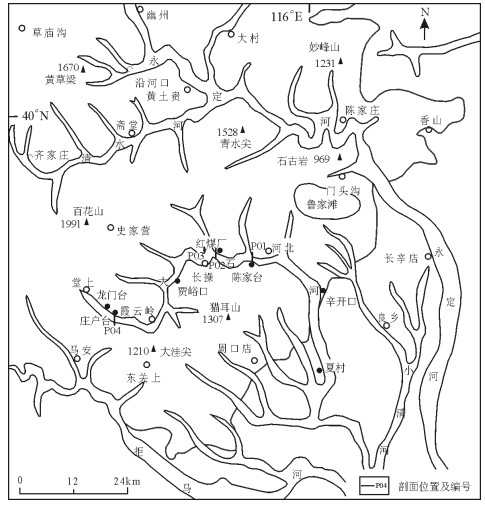
 下载:
下载:

